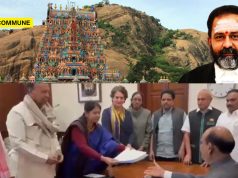
After the closure of a copper smelting plant few years ago, the state of Tamil Nadu has now also halted plans for the establishment of a tungsten mining project in Madurai.
What could have been a big opportunity for industry-driven development in the long-neglected southern part of the state, which has been yearning for industrial growth, has once again been deprived of development.
Unbecoming Of A Development-Oriented Party
The romanticization of agriculture through pop culture, along with vested interests using farmers as props for protests, has led to a distorted narrative that overlooks the real challenges faced by the farming community and hinders meaningful policy-driven solutions.
In the past, any attempts to shut down the extraction of crucial minerals or metals would have faced strong opposition from communist groups in the states, often citing environmental degradation and stirring public emotions by warning of polluted river waters and other negative consequences. It is understandable if the DMK and Dravidianist parties oppose a development project for their politics. Afterall, their post-2014 anti-development politics doesn’t arise from genuine concern for the people or environment but is driven purely by an obsessive hatred for one man – Modi.
But it is a tragedy that the Central Government was compelled to cancel the Tungsten Mining project in the wake of protests and political grandstanding.
What is even more tragic and shameful is the Tamil Nadu BJP’s enthusiastic chest-thumping, eagerly taking credit for the closure. It is unbecoming of a nationalistic, development-oriented party like the BJP to take pride in playing a role in preventing an industry from being established.
Mineral exploration and extraction are vital economic drivers for any country. Take the Gulf nations, for example—despite experts predicting that their crude oil reserves will last for another century, they continue to extract and capitalize on it, using the revenue to support various aspects of their economies. In contrast, here, we are witnessing a missed opportunity to harness our natural resources for national benefit. China is already heavily investing in sourcing rare-earth minerals required for the semiconductor and electric vehicle industry and India is already way behind thanks to our democracy.
Yes, there could be a valid grouse amongst the people of the Arittapatti and Nayakkarpatti villages. Yes, there are heritage sites in the surrounding region which must be protected. Yes, there could be concerns about the ecological impact. But development and economic progress comes at a small cost of the environment. The investing company should be made responsible for CSR activities to protect the environment and heritage of the sites. No company is insane to demolish an ancient protected heritage site to put its factory.
Annamalai himself had spoken about the importance of the tungsten mining project. What changed later? We don’t know.
டங்ஸ்டன் சுரங்கத்தை அனுமதிக்கக் வேண்டும் என ஆதரித்து பேசிய அண்ணாமலை @annamalai_k #TungstenProtest #Tungsten #Madurai #Arittapatti pic.twitter.com/bPMEmjYqI0
— JANU (@ShekarJanani) January 23, 2025
Probably, the intelligence agencies sensed another Sterlite protest type situation. That raises several important questions: Have no lessons been learned from that episode? What prevents the Centre from conducting thorough due diligence? Why aren’t intelligence agencies monitoring potential troublemakers? And what stops the BJP state unit from engaging with the public, educating them, and garnering their support? What stops them from working on a consensus among political parties to put national interest over political interest?
Why Tungsten Matters?
Tungsten, also known as ‘wolfram,’ is a dense, lustrous, grayish-white metal with a high melting point of 3,422°C, the highest of all metals. Its brittleness makes it challenging to work with, but its strategic importance cannot be overstated. Tungsten is essential for various industrial applications and is crucial for the economic development of any country. It does not occur naturally in its pure form but is found in minerals like scheelite (calcium tungstate, CaWO4) and wolframite, which are primarily hydrothermal in origin.
Tungsten is highly valued for its unique properties, including resistance to corrosion, good thermal and electrical conductivity, and a low coefficient of expansion. It is elastic, ductile, and boasts high tensile strength, making it ideal for applications such as light bulb filaments, vacuum tubes, and electrical furnace heating elements. Its high electron emissivity, thermal stability, and chemical resistance make it critical for thermo-emission applications.
In steel production, small amounts of tungsten are added to enhance hardness, and it is widely used in military applications, such as making armor-piercing ammunition. Tungsten carbide, one of the hardest synthetic materials, is used in industries like mining, construction, metalworking, and oil drilling. Other applications include use in dyes, pigments, ceramics, and as a substitute for lead in bullets and shot.
This valuable metal is also used in strategic industries like aerospace, defense, semiconductors. Tungsten is used in projectiles, armor-piercing shells, missiles, and aircraft components due to its high density and heat resistance. Tungsten alloys are used in nuclear reactors, power plants, and renewable energy technologies like wind turbines.
Many countries stockpile tungsten to ensure a steady supply, given its limited global production and the geopolitical risks associated with its mining and trade. With advancements in space exploration, electronics, nuclear, robotics, and medical technology, tungsten’s importance is only expected to grow, further cementing its status as a strategic resource.
The Domestic Supply Of Tungsten
India currently meets its domestic tungsten requirements mainly through imports, as there is no significant local production. A significant portion of tungsten is recovered through recycling, especially from alloys and waste. The Ministry of Mines highlights that tungsten’s primary uses include ferro-tungsten production for special and alloy steels, as well as military applications. Ferrotungsten contains between 25% and 75% tungsten, and tungsten carbide is crucial in manufacturing cutting tools and wear-resistant materials.
Tungsten’s importance extends to its role in high-temperature applications, such as heating elements, and its ability to act as a radiation shield, in ornaments, superalloys, and in the chemical and electronics industries. Its alloyed forms are used in numerous sectors, including electronics, aerospace, and defense.
China Sits On A Pile While India Imports
China holds a dominant position in the global tungsten market, producing over 80% of the world’s tungsten. The country’s reserves account for more than half of the global total. In 2019, world tungsten production increased by 12%, with China leading the charge, followed by other countries like Vietnam, Russia, and several European nations.
The global tungsten market is growing due to its applications across multiple sectors such as automotive, industrial engineering, energy, and aviation. Tungsten carbide remains the largest application segment, primarily used in cutting, drilling, and boring tools. The mill products segment, including tungsten electrodes, filaments, and wires, is also significant, driven by demand from the electronics industry.
In India, the full demand for tungsten is met by imports and recycling, and there is potential to tap into local resources. For example, the tailing dumps in Kolar, which contain high amounts of tungsten, could be a priority for extraction to meet domestic needs.
While China continues to dominate the tungsten market, it has also imposed regulations, including export quotas and restrictions on mining, which impacts global availability. Recycling remains a vital source of tungsten, as the material is highly valuable and can be reused in various industries. In the wake of the COVID-19 pandemic, global tungsten consumption saw a decline, especially in automotive and aerospace sectors, which are major consumers of the metal.
Looking ahead, the tungsten market is expected to face challenges, particularly from the ongoing US-China trade tensions, which could affect production and distribution. However, opportunities remain in industries such as semiconductors, consumer electronics, and superalloys. As new mines in China and Russia approach their end of life, new projects are needed to ensure adequate supply in the future.
How The Madurai Tungsten Issue Unfolded
The Geological Survey of India (GSI) handed over the Geological Memorandum (GM) for tungsten deposits in Madurai to the Tamil Nadu government on September 14, 2021, granting them authority to auction minerals. However, the 2023 amendment to the Mines and Minerals Act shifted auction rights for critical minerals like tungsten to the Central Government.
After the amendment, the Ministry of Mines informed Tamil Nadu on September 15, 2023, about the upcoming auction of critical mineral blocks, including the Nayakkarpatti Tungsten Block. In response, the Tamil Nadu Water Resources Minister sent a letter on October 3, 2023, opposing the amendment and requesting that states retain auction rights for critical minerals. However, Tamil Nadu had not conducted any mineral auctions during the period from 2021 to 2023, when it had the authority, nor in the previous nine years under the auction framework.
On December 6, 2023, the Ministry of Mines requested details about three critical mineral blocks, including Nayakkarpatti, for auction. Tamil Nadu’s Commissioner of Geology and Mining provided the required information on February 8, 2024, acknowledging the presence of a biodiversity heritage site covering around 10% of the Nayakkarpatti block but did not oppose the auction.
The Nayakkarpatti Tungsten Block, spanning 20.16 sq. km, was offered for auction as a Composite License (CL) in February 2024. After an unsuccessful first attempt, the block was re-notified in June 2024. Hindustan Zinc Ltd. was declared the preferred bidder in November 2024. Despite biodiversity concerns, Tamil Nadu did not raise formal objections during multiple auction-related discussions between February and November 2024.
In November 2024, the Union Ministry of Mines granted mining rights to Hindustan Zinc Limited, a subsidiary of Vedanta Limited, for the Nayakkarpatti block in Melur taluk, Madurai district. This decision was met with substantial opposition from local communities, environmental activists, and the Tamil Nadu state government.
A Composite License involves a two-stage process: initial exploration and delineation of mineral zones, followed by obtaining environmental and government clearances to transition into mining. Sensitive areas, such as biodiversity heritage sites, are generally excluded during this clearance phase—a process overseen by the state government.
The Ministry of Mines’ role is limited to auctioning critical minerals to drive economic growth. Subsequent responsibilities, such as issuing Letters of Intent (LOI) and granting mining leases, remain with the state government. Revenue from mineral production directly benefits the state.
On January 7, 2025, thousands of villagers and farmers from approximately 40 villages, including Melur, organized a large-scale protest.
In response to the public outcry, Tamil Nadu Chief Minister M.K. Stalin urged the Union government to cancel the mining rights, emphasizing the need to protect the area’s ecological and cultural heritage.
Subsequently, the Union Ministry of Mines announced the cancellation of the tungsten mining license in Madurai, acknowledging the widespread protests and concerns raised by various stakeholders.
Yet Another Ploy Against Vedanta By Vested Interests?
Until 2018, India was a net exporter of copper, with refined copper exports reaching 378,555 tonnes in 2017-18. However, this dropped sharply to just 47,917 tonnes in 2018-19. In response to a question from Majeed Memon of the NCP, Commerce and Industry Minister Piyush Goyal explained in the Rajya Sabha that the closure of the Sterlite Copper Smelter plant in May 2018 led to a decline in both domestic production and exports. Sterlite, with a capacity of 400,000 tonnes per year, accounted for 40% of India’s total copper production.
In contrast, Pakistan’s copper exports to China surged significantly, from USD 35 million in 2017 to USD 308.17 million in 2019, according to the United Nations COMTRADE database. Some reports even cited a 400% increase, estimating exports at USD 550 million in 2019. While the figures vary, the overall trend indicates a remarkable rise in copper exports from Pakistan to China.
This comparison isn’t intended to suggest that China or Pakistan caused the closure of Sterlite, but it highlights how a social unrest against Vedanta’s Sterlite was leveraged by these two countries to boost their own copper exports.
In the case of tungsten, Hindustan Zinc, a subsidiary of Vedanta Limited, having emerged as the preferred bidder once again faces setback in establishing in unlocking the potential of India’s tungsten resources. The project’s future remains uncertain due to political opposition and environmental concerns, which have led to delays and calls for further review. Could this again be a doing of the DMK and vested interests? We don’t know.
The Least TN BJP Can Do – Not Ape The Dravidian Parties
Tungsten is a critical resource with numerous industrial applications, and its strategic importance will continue to grow as demand for advanced materials increases. With global supply largely dependent on China, countries like India must explore domestic mining and recycling initiatives to reduce dependence on imports. Sustainable use of tungsten and investment in new mining projects will be crucial for meeting future demand and securing this vital metal for technological and economic advancement.
Unlike regional parties like the DMK and communists, who often rely on short-term electoral gains, national parties should focus on instilling hope and highlighting the long-term benefits of crucial projects for the nation’s growth.
The current opposition to tungsten in Madurai is nothing when compared to what the Gujarat Government faced for the Sardar Sarovar Dam Project when Narendra Modi was Chief Minister. The BJP government there did not succumb to the pressure tactics of the vested interests. Today, the people living in the arid parts of Gujarat enjoy the benefits of the project and the likes of Medha Patkar have been made to suck their thumbs.
India is not an authoritarian country like China, where decisions are made top-down; where, the land belongs to the states and can be used as they see fit. However, the right approach would be to take precautionary measures, do a sensitization campaign, ensure proper rehabilitation, assurance of jobs to the displaced locals. Having failed to take confidence-building measures in favour of the project, the least that the Tamil Nadu BJP can do is not go around taking credit for shutting the doors of development to the parched people of south Tamil Nadu.
Kaushik is a political writer.
Subscribe to our channels on Telegram, WhatsApp, and Instagram and get the best stories of the day delivered to you personally.




